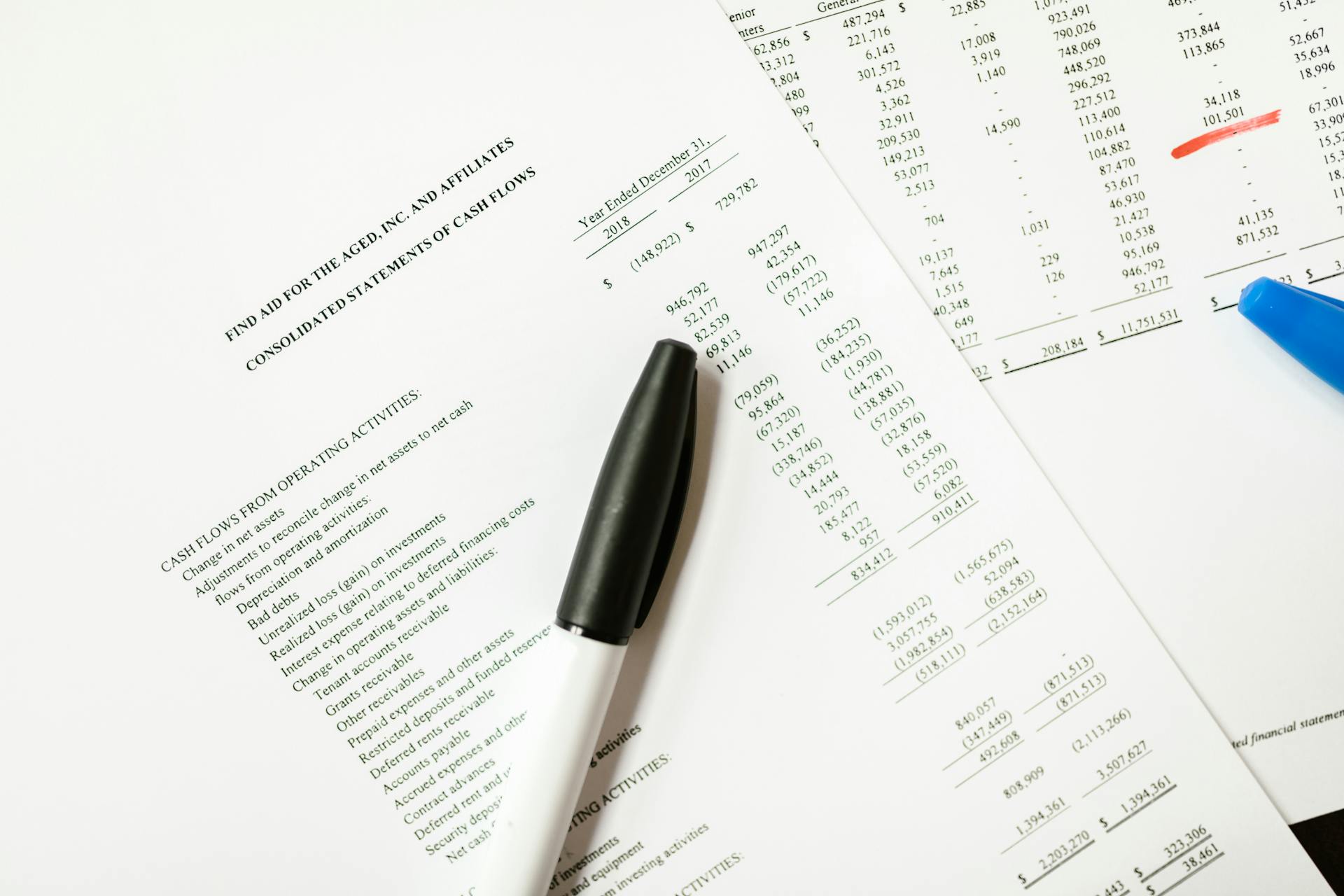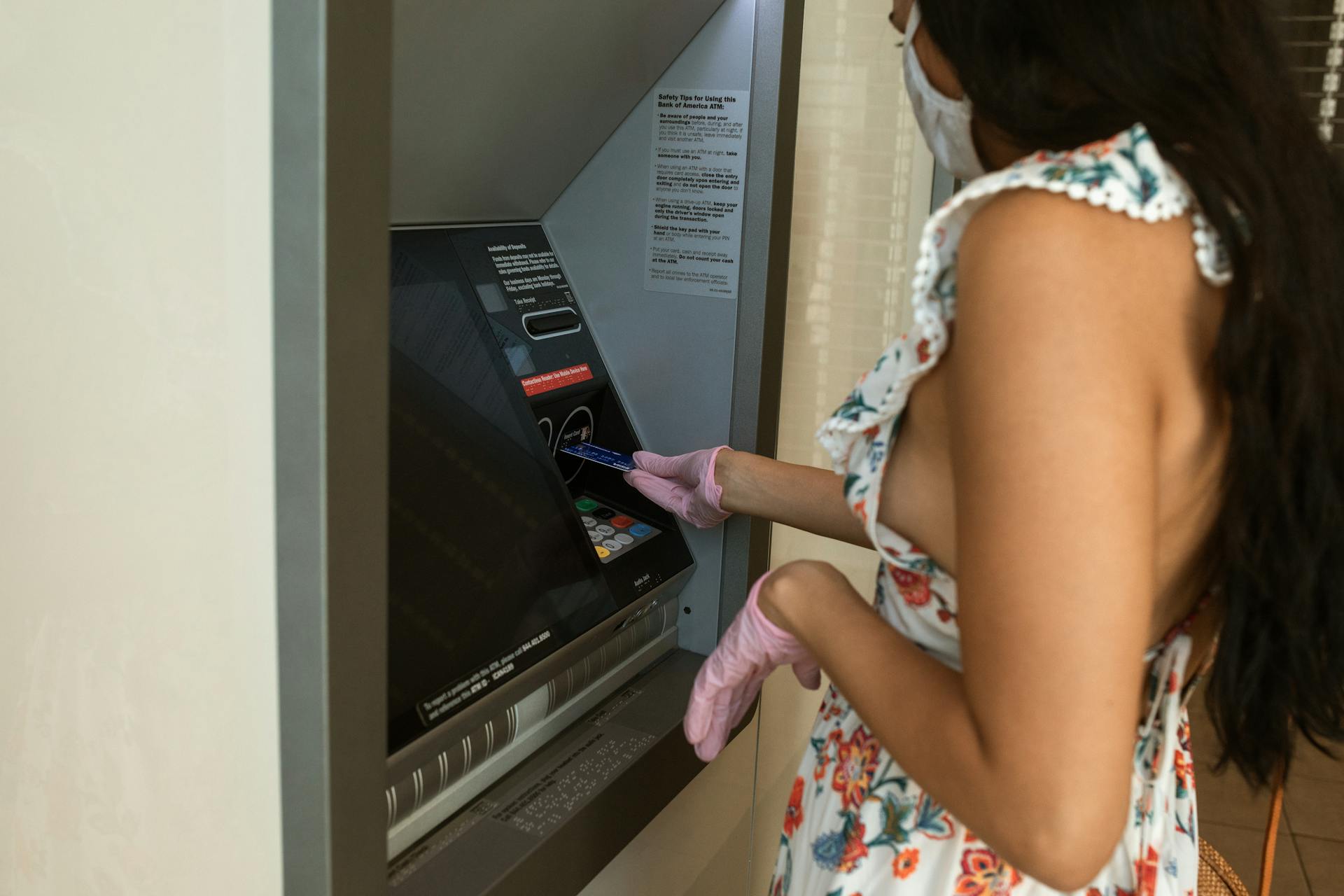
Discounted Cash Flow Analysis is a powerful tool for estimating future cash flows. It helps investors and businesses understand the present value of future cash inflows and outflows.
This method involves calculating the net present value of future cash flows by discounting them back to their present-day value using a discount rate. The discount rate reflects the time value of money, which means that a dollar today is worth more than a dollar tomorrow.
A common approach is to use a constant growth rate to model future cash flows, as seen in the example where a company's cash flows grow at a rate of 5% per year. This simplifies the analysis and provides a more straightforward way to estimate future cash flows.
By using historical data and industry benchmarks, you can estimate the growth rate and discount rate to use in your analysis.
Consider reading: Discount Rate of Cash Flows
What is DCF
Discounted Cash Flow (DCF) is a powerful tool used to evaluate the attractiveness of an investment by comparing its calculated intrinsic value to its market price. It's a way to calculate the present value of future cash flows.
The DCF formula takes into account three key components: cash flows, discount rate, and time period. Cash flows are the expected inflows and outflows that will be generated by the investment in the future. The discount rate reflects the risk associated with the investment, and a higher discount rate indicates higher risk. Time period is the point at which each cash flow is expected to occur.
A discount rate of 5% was used in an example to evaluate a project's worth. The company's WACC was 5%, and the initial investment was $11 million. The project's estimated cash flows were $1 million for the first two years, $4 million for the next two years, and $6 million in the final year.
The DCF formula helps investors and analysts assess the attractiveness of an investment by comparing its calculated intrinsic value to its market price. If the calculated DCF value is higher than the market price, the investment may be considered undervalued.
Here are the components of the DCF formula:
- Cash Flows (CFt): The expected cash inflows and outflows that will be generated by the investment in the future.
- Discount Rate (r): The discount rate reflects the risk associated with the investment.
- Time Period (t): Each cash flow is discounted to its present value, considering the time period at which it is expected to occur.
In another example, a discount rate of 10% was used to calculate the present value of a stream of future cash flows. The cash flows were $100 per year for three years, and the present value of each cash flow was calculated by reducing it by the discount rate.
Additional reading: Equity Internal Rate of Return
Calculating DCF
Calculating DCF involves three basic steps. One, forecast the expected cash flows from the investment. Two, select a discount rate, typically based on the cost of financing the investment or the opportunity cost presented by alternative investments. Three, discount the forecasted cash flows back to the present day.
To calculate the DCF, you can use the formula: DCF = Σ (CFt / (1 + r)^t), where DCF is the discounted cash flow value, Σ represents the summation of cash flows over a specified period, CFt refers to expected cash flow at time t, r is the discount rate, and t represents the time period when the cash flow is received.
The discount rate can be based on the company's WACC, which incorporates the average rate of return that shareholders in the firm are expecting for the given year. For example, if the company's WACC is 5%, you would use 5% as your discount rate.
You might enjoy: Future Cash Flows Expected from Investment Projects Blank______.
How It Works
Discounted cash flow analysis works by finding the present value of expected future cash flows using a discount rate.
The time value of money assumes that a dollar today is worth more than a dollar tomorrow because it can be invested.
At a 5% annual interest rate, $1 in a savings account will be worth $1.05 in a year.
A payment delayed for a year will have a present value of 95 cents because it cannot earn interest.
To conduct a DCF analysis, an investor must make estimates about future cash flows and the end value of the investment.
The investor must also determine an appropriate discount rate, which will vary depending on the project or investment.
Factors like the company's risk profile and capital market conditions can affect the discount rate chosen.
If estimates are too high, the eventual payoff of the investment will be overvalued.
Likewise, estimating too low may make the investment appear too costly for the eventual profit.
Here's an interesting read: Where Does Interest Expense Go on Cash Flow Statement
DCF Formula
The DCF formula is a powerful tool for calculating the present value of expected future cash flows. It's expressed as DCF = Σ (CFt / (1 + r)^t), where CFt is the expected cash flow at time t, r is the discount rate, and t represents the time period when the cash flow is received.
The DCF formula helps investors and analysts assess the attractiveness of an investment by comparing its calculated intrinsic value to its market price. The formula is a summation of cash flows over a specified period, where each cash flow is discounted to its present value considering the time period at which it is expected to occur.
To calculate the DCF, you need to forecast the expected cash flows from the investment, select a discount rate, and discount the forecasted cash flows back to the present day. The discount rate is typically based on the cost of financing the investment or the opportunity cost presented by alternative investments.
You might enjoy: Operating Cash Flows Formula
The discount rate is a crucial component of the DCF formula, as it reflects the risk associated with the investment. A higher discount rate indicates higher risk and a lower present value. The discount rate can vary based on the company's risk profile, market conditions, and the specific project's risk.
Here's a breakdown of the components of the DCF formula:
- Cash Flows (CFt): These are the expected cash inflows and outflows that will be generated by the investment in the future.
- Discount Rate (r): The discount rate reflects the risk associated with the investment.
- Time Period (t): Each cash flow is discounted to its present value, considering the time period at which it is expected to occur.
A higher discount rate indicates higher risk and a lower present value, making it essential to choose the right discount rate for the DCF model. Factors such as the company or investor's risk profile and the conditions of the capital markets can affect the discount rate chosen.
In summary, the DCF formula is a powerful tool for calculating the present value of expected future cash flows. By understanding the components of the formula and selecting the right discount rate, investors and analysts can make informed decisions about investments and projects.
If this caught your attention, see: Internal Rate of Return Npv
Advantages and Disadvantages
Discounted cash flow analysis can provide a reasonable projection of whether a proposed investment is worthwhile.
It's an analysis that can be applied to various investments and capital projects where future cash flows can be reasonably estimated.
This analysis can help users account for different projections that might be possible by tweaking its projections.
Discounted cash flow analysis is a valuable tool for investors and companies looking to make informed decisions about their investments.
Here's an interesting read: How to Analyze a Cash Flow Statement
Advantages
Discounted cash flow analysis is a valuable tool for investors and companies. It provides a reasonable projection of whether a proposed investment is worthwhile.
One of the key benefits of this analysis is that it can be applied to a variety of investments and capital projects. This means it's not limited to just a few specific types of projects.
Its projections can be tweaked to provide different results for various what-if scenarios. This helps users account for different projections that might be possible.
Discounted cash flow analysis is also useful for investment evaluation. It helps you determine whether an investment is a good opportunity.
Here are some specific advantages of discounted cash flow analysis:
- Investment evaluation
- Applicable to a variety of projects
- Adjustable scenarios
Disadvantages

Discounted cash flow analysis is a powerful tool for evaluating investment opportunities, but it's not without its limitations. One major issue is that it relies on estimates, not actual figures, which can lead to inaccurate results.
The result of a discounted cash flow analysis is an estimate, and for it to be useful, investors and companies must estimate a discount rate and cash flows correctly. This can be a challenging task, especially when considering the many factors that can affect future cash flows.
Future cash flows are influenced by a variety of factors, such as market demand, the economy, technology, competition, and unforeseen threats or opportunities. These factors can't be quantified reliably, making it difficult to accurately forecast future cash flows.
Companies and investors should consider other valuation methods, such as comparable company analysis and precedent transactions, when evaluating an investment opportunity. This can help provide a more comprehensive understanding of the investment's potential.
Intriguing read: Investors Assess Cash Flows before

Here are some of the specific difficulties associated with using discounted cash flow analysis in valuation:
- Forecast reliability: Traditional DCF models assume we can accurately forecast revenue and earnings 3–5 years into the future, but studies have shown that growth is neither predictable nor persistent.
- Discount rate estimation: The capital asset pricing model, traditionally used to assess the riskiness of an investment, has been empirically invalidated by some economists.
- Input-output problem: DCF is subject to the principle "garbage in, garbage out", where small changes in inputs can result in large changes in the value of a company.
- Missing variables: Traditional DCF calculations only consider the financial costs and benefits of a decision, ignoring environmental, social and governance performance.
Analyze Sensitivity
Analyzing sensitivity is a crucial step in evaluating the reliability of a DCF valuation. It involves evaluating how changes in key inputs affect the valuation.
One way to perform sensitivity analysis is to model different scenarios, such as conservative, base, and optimistic, to understand the range of possible outcomes. This will give you a better idea of how sensitive the valuation is to changes in key inputs.
Scenario analysis is particularly important because DCF is highly sensitive to the assumptions you make. By evaluating how changes in key inputs, such as the discount rate or growth rate, affect the valuation, you can get a more accurate picture of the company's value.
To model different scenarios, you can use sensitivity analysis to evaluate how changes in key inputs affect the valuation. This will help you identify the most critical inputs and how they impact the overall valuation.
Here are some common scenarios to consider:
- Conservative scenario: This scenario assumes a lower discount rate and lower growth rate to reflect a more pessimistic outlook.
- Base scenario: This scenario assumes a moderate discount rate and growth rate to reflect a neutral outlook.
- Optimistic scenario: This scenario assumes a higher discount rate and higher growth rate to reflect a more optimistic outlook.
Calculating NPV
Calculating NPV is a straightforward process that builds on the discounted cash flow calculation.
To start, you need to forecast the expected cash flows of an investment. This will give you a sense of how much money you can expect to receive over time.
The next step is to select a discount rate, which will help you determine the present value of those future cash flows.
Discounting those cash flows is done by multiplying each cash flow by a discount factor, which is calculated by dividing 1 by (1 + discount rate)^time period.
The discount rate is a critical factor in calculating NPV, as it can significantly impact the final result.
After totaling the discounted cash flows, you'll need to deduct the upfront cost of the investment to arrive at the NPV.
For example, if the cost of purchasing an investment is $200, then the NPV would be the total of the discounted cash flows minus $200.
Best Practices for Analysis
To conduct a thorough analysis of future cash flows, it's essential to understand the best practices for analysis.
One best practice is to identify and quantify all potential sources of cash inflows and outflows.
A well-structured analysis should consider both expected and unexpected events that may impact future cash flows.
To accurately forecast future cash flows, it's crucial to use a reliable and consistent method, such as a discounted cash flow analysis.
A DCF analysis involves estimating the present value of all future cash flows, taking into account their timing and risk.
To minimize errors, it's best to use a detailed and transparent cash flow model that includes all relevant assumptions and inputs.
Choose a Suitable Discount Rate
Choosing a suitable discount rate is crucial in determining the present value of future cash flows. This rate should reflect the risk and timing of the cash flows.
The discount rate incorporates two key components: the time value of money and the risk premium. The time value of money is the risk-free rate, which reflects the idea that investors prefer to have cash immediately rather than waiting.
The risk premium is an extra return that investors demand due to the risk that the cash flow might not materialize. This premium is typically calculated as a function of the asset's performance with reference to some macroeconomic variable.
For example, the Capital Asset Pricing Model (CAPM) compares the asset's historical returns to the overall market's. This method is commonly used in industry, but there are alternative approaches, such as the "T-model", which relies on accounting information.
In practice, the discount rate may be modified by industry or specific settings, such as healthcare or mining. For instance, various formulae have been proposed for choosing a discount rate in a healthcare setting.
To ensure consistency, make sure the discount rate aligns with the frequency of the cash flow projections. This means using annual, quarterly, or monthly rates depending on the frequency of the cash flows.
Here are some common approaches to choosing a discount rate:
- Cost of Capital: Use the company’s weighted average cost of capital (WACC) as the discount rate.
- Risk Adjustments: For higher-risk projects, you may need to adjust the discount rate to reflect specific risks.
- Consistent Units: Make sure the discount rate aligns with the frequency of the cash flow projections.
Cash Flow Focus
When evaluating future cash flows, it's essential to focus on the right metrics. Free Cash Flow to the Firm (FCFF) is often the preferred metric for DCF analysis, representing the cash flow generated by the business that is available to all capital providers.
There are two types of free cash flow to consider: FCFF and FCFE. FCFF represents the cash flow available to all capital providers, while FCFE represents the cash flow available after debt repayments.
To illustrate the importance of focusing on free cash flow, consider a business that generates $100,000 in cash flow from operations, but also has $50,000 in capital expenditures. The FCFF would be $50,000, representing the cash flow available to all capital providers.
Here's a quick summary of the two types of free cash flow:
Understanding the difference between FCFF and FCFE is crucial when evaluating future cash flows and making informed financial decisions.
Document Assumptions & Rationale
Documenting your assumptions and rationale is a crucial step in creating a reliable model for projecting future cash flows. This ensures transparency and allows others to follow your reasoning and ensure consistency.
Transparency is key, so make sure to document all assumptions used in the model, such as growth rates, risk factors, and capital expenditures. This includes keeping track of inflation, depreciation, and capital expenditures, which significantly affect free cash flow.
Incorporating realistic assumptions about depreciation, capital expenditures, and working capital requirements is essential. Accurately accounting for taxes also reflects the impact on free cash flow.
To validate your assumptions, get third-party validation or historical data to back up key assumptions, especially for revenue and growth rates. This adds an extra layer of credibility to your model.
Here are some key assumptions to document:
- Growth rates
- Risk factors
- Capital expenditures
- Depreciation
- Working capital requirements
- Taxes
Example and Calculation
Calculating the present value of future cash flows is a crucial step in evaluating investments. This is done using the Discounted Cash Flow (DCF) formula, which takes into account the expected cash flows, discount rate, and time period.
The discount rate is a critical component of the DCF formula, reflecting the risk associated with the investment. As seen in Example 3, a discount rate of 10% was used to calculate the present value of future cash flows. This rate was chosen based on the opportunity cost of investing in the project.
The time period is also an essential factor in the DCF formula, as each cash flow is discounted to its present value considering the time period at which it is expected to occur. Typically, cash flows are projected into the future for several years, as seen in Example 4.
The DCF formula helps investors and analysts assess the attractiveness of an investment by comparing its calculated intrinsic value to its market price. If the calculated DCF value is higher than the market price, the investment may be considered undervalued, potentially presenting an attractive opportunity.
Here's a breakdown of the components of the DCF formula:
- Cash Flows (CFt): These are the expected cash inflows and outflows that will be generated by the investment in the future.
- Discount Rate (r): The discount rate reflects the risk associated with the investment.
- Time Period (t): Each cash flow is discounted to its present value, considering the time period at which it is expected to occur.
To illustrate the importance of the DCF formula, consider the example of Netflix, which used DCF analysis to evaluate the profitability of its content investments. By discounting projected cash flows back to their present value, Netflix could make informed decisions about its content strategy.
Here's an example of how to calculate the present value of future cash flows using the DCF formula:
In this example, the discount rate was 5%, and the present value of the future cash flows was calculated to be $13,306,727.
Methods and Approaches
There are various methods to appraise a company or project, and some of these methods are outlined below. The details of each method can vary depending on the capital structure of the company.
The Flows to Equity approach (FTE) is one of the methods used for valuation purposes. This method is likely to be at least as important as the precise model used, as the assumptions used in the appraisal, especially the equity discount rate and the projection of the cash flows to be achieved, play a crucial role.
The valuation result obtained with each method is determined by both the income stream selected and the associated cost of capital model.
A different take: Sample of Cash Flow Statement Indirect Method
Sources
- https://www.investopedia.com/terms/d/dcf.asp
- https://www.open.edu/openlearn/money-business/challenges-advanced-management-accounting/content-section-4.3.1
- https://www.calculatorsoup.com/calculators/financial/future-value-cash-flows-calculator.php
- https://en.wikipedia.org/wiki/Discounted_cash_flow
- https://www.invensis.net/blog/what-is-discounted-cash-flow
Featured Images: pexels.com


